Lets Take a Chance Go Far Away Today and Never Look Back Again
If Planet Nine exists, why has no 1 seen it?
(Epitome credit:
ESA/Hubble, M. Kornmesser
)
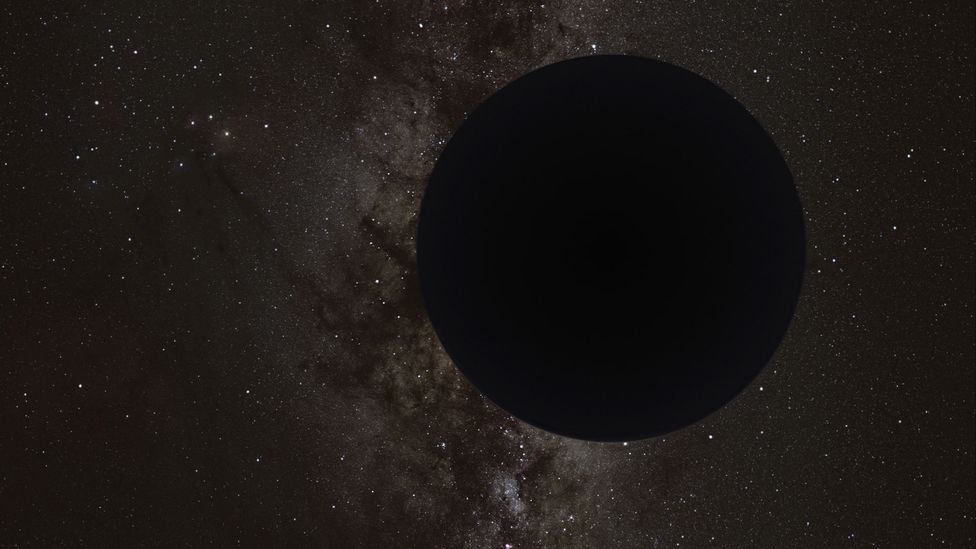
Strange things are happening at the outer edges of our solar system. An object up to x times the mass of Earth is pulling others towards information technology. Is it a planet, or something else?
A
Equally we head towards the end of another boggling year, BBC Future is taking a look dorsum at some of our favourite stories for our "Best of 2021" collection. Notice more of our picks here.
Percival Lowell was a man of many errors.
The 19th-Century travel author and man of affairs – fabulously wealthy, perennially moustachioed, and often found in crisp 3-piece suits – had read a book on Mars, and on this basis, decided to become an astronomer. Over the coming decades, he fabricated a number of wild claims.
Beginning up, he was convinced of the being of Martians, and thought he had found them (he hadn't). Others had documented strange lines traversing the planet, and Lowell suggested that these were canals, built as the last attempt of a dying civilization to tap water from the polar ice caps. He used his fortune to build an unabridged observatory, merely to get a better expect. It turned out they were an optical illusion, created past the mountains and craters on Mars when viewed through depression quality telescopes.
Lowell likewise believed that the planet Venus had spokes – seen in his notes as spidery lines emanating from its centre (it doesn't). Though his assistants tried to detect them, it seemed that only he could encounter this unexpected detail. It's at present causeless that they were shadows cast from the irises in his ain eyes, equally he looked through his telescope.
Just most of all, Lowell was determined to find the ninth planet in our solar system – a hypothetical "planet X", which at the time was thought to be responsible for the rogue orbits of the furthest-known planets from the Lord's day, the cool-blue water ice giants Uranus and Neptune. Though he never gear up eyes on this phantom behemoth, the quest consumed the last decade of his life – and after several nervous breakdowns, he died at the age of 61.
Little did he know, the search would still be going – with a few tweaks – in 2021.
A false trail
Undeterred past his ain mortality, Lowell left a million dollars to the cause of finding planet X in his will. So, subsequently a brief interlude involving a legal battle with his widow, Constance Lowell, his observatory kept looking.
Only fourteen years later, on 18 February 1930, a young astronomer was looking at 2 photos of star-studded skies, when he noticed a speck amid them. Information technology was a tiny world. He had found Pluto – for a while considered the elusive planet 10.
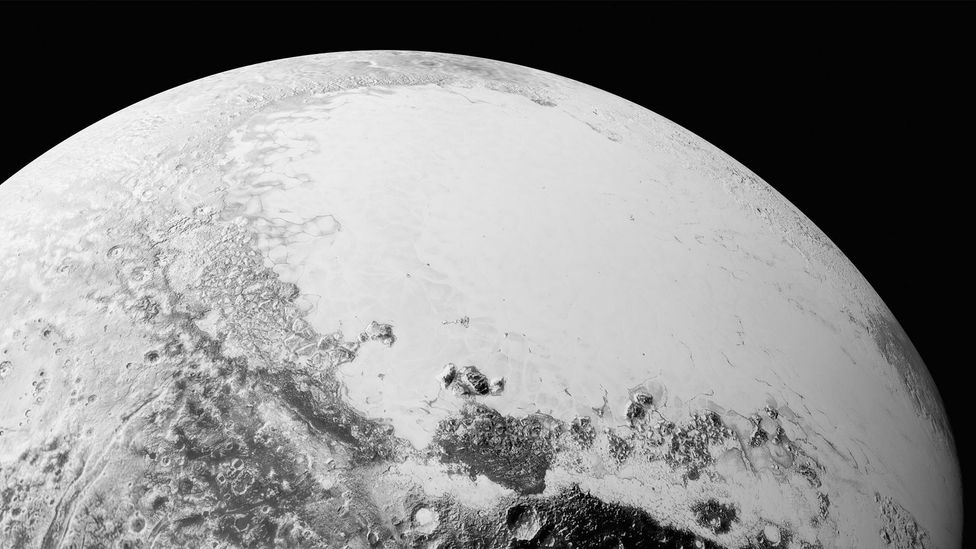
Pluto was demoted to a dwarf planet in 2006, leaving an opening for a new ninth planet (Credit: NASA/ Johns Hopkins University /Southwest Enquiry Institute)
Alas, it was not to be. Soon scientists realised that this could non be what Lowell was looking for – information technology was non most large enough to pull Neptune and Uranus away from their rightful positions. Pluto was just an accidental interloper, which happened to be in the surface area.
The last blow to planet 10 came in 1989, when the Voyager 2 spacecraft swept by Neptune and revealed that it's fractionally lighter than anyone had originally thought. With this in mind, somewhen a Nasa scientist calculated that the orbits of the outer planets had made sense all along. Lowell had instigated a search that had had never been needed.
But just as the concept of a subconscious planet was killed off, the groundwork was laid for its resurrection.
You might also like:
- Voyager: Within the globe's greatest space mission
- Should astronauts abandon the space station?
- Spaceplanes: The render of the reusable spacecraft?
In 1992, two astronomers who had "doggedly scanned the heavens in search of dim objects beyond Neptune" for years, according to Nasa, discovered the Kuiper Belt. This cosmic donut of frozen objects, extending just beyond the orbit of Neptune, is 1 of the largest features in the solar system. It'southward then vast, it's thought to incorporate hundreds of thousands of objects larger than 100km (62 miles) across, equally well as upward to a trillion comets.
Soon scientists realised that Pluto was unlikely to exist the only big object in the outer reaches of the solar system – and began to question whether it was actually a planet at all. And then they found "Sedna" (effectually forty% of the size of Pluto), "Quaoar" (around half the size of Pluto), and "Eris" (most the same size as Pluto). It became clear that astronomers needed a new definition.
In 2006, the International Astronomical Union voted to demote Pluto's condition to a "dwarf planet", along with the newcomers. Mike Brownish, a professor of planetary astronomy at the California Institute of Engineering science – Caltech – who led the squad that identified Eris, is cocky-styled as the "man who killed Pluto" to this day. The ninth planet was no more.
A ghostly signature
At the same fourth dimension, the discovery of these objects uncovered a major new atomic number 82 in the search for a hidden planet.
It turns out that Sedna is not moving in the manner everyone expected – tracing elliptical rings effectually the Sun, from within the Kuiper Chugalug. Instead, this dwarf planet takes a bizarre and unexpected path, swinging from merely 76 Earth-Sun distances (roughly xi billion k/7 billion miles) from the heart of our solar system to more than than 900 (roughly 135 billion km/84 billion miles). Its orbit is so meandering, it takes 11,000 years to complete – the terminal time Sedna was at its current position, humans had only simply invented farming.

Percival Lowell established his observatory in Flagstaff, Arizona to look for intelligent life on Mars. Somewhen it was used to find Pluto (Credit: Alamy)
It'southward as though something is tugging at Sedna and dragging it abroad.
Enter a hypothetical new addition to our solar system – simply non as it was thought of before. In 2016, the same Mike Brown who had slain Pluto, together with his colleague Konstantin Batygin – besides a professor of planetary science at Caltech – co-authored a paper proposing a massive planet, betwixt five and 10 times the size of Earth.
Their idea came from the observation that Sedna was not the merely object out of identify. It was joined by six others, and all of them are being pulled in the aforementioned direction. At that place are besides other clues, such as the fact that each is tilted on its axis in exactly the same direction. The pair calculated that the probability of all six objects being pulled in the exact same direction, with the same tilt by take a chance was just 0.007%.
"Nosotros idea 'this is quite interesting – how tin can this be?'" says Batygin. "Information technology was quite remarkable because such a clustering, if left solitary for a sufficiently long menstruum of time, would disperse, just due to interaction with the gravity of the planets."
Instead, they proposed that Planet 9 had left its ghostly imprint in the outer reaches of our solar arrangement, distorting the orbits of the objects around information technology with its gravitational pull. Several years on, and the number of objects that fit the eccentric orbital pattern and tilt has continued to increment, "We at present have effectually 19 overall," says Batygin.
Though no one has yet seen the hypothetical planet, it'southward possible to infer a surprising amount about it. As with the other objects beyond the Kuiper Chugalug, the orbit of the new Planet Nine would be and so distorted that its farthest accomplish is expected to be twice as far away as its nearest – effectually 600 times the distance from the Dominicus to Earth (90 billion km/56 billion miles), vs 300 (45 billion km/28 billion miles). Scientists accept also hazarded a guess at its artful – icy, with a solid core, like Uranus or Neptune.
Then there's the slippery question of where Planet Nine might accept come from in the first identify. So far, there are iii main ideas. Ane is that it formed where it currently hides, which Batygin dismisses as relatively unlikely because this would require the early solar system to have stretched out as far as its distant refuge.
There'south also the intriguing proposition that the ninth planet is actually an alien imposter, an object that was stolen from some other star long ago when the Sun was yet in the stellar cluster in which it was built-in. "The problem with such a story is that y'all're just as likely to then lose the planet upon the adjacent meet," says Batygin. "And so, statistically, that model runs into trouble."
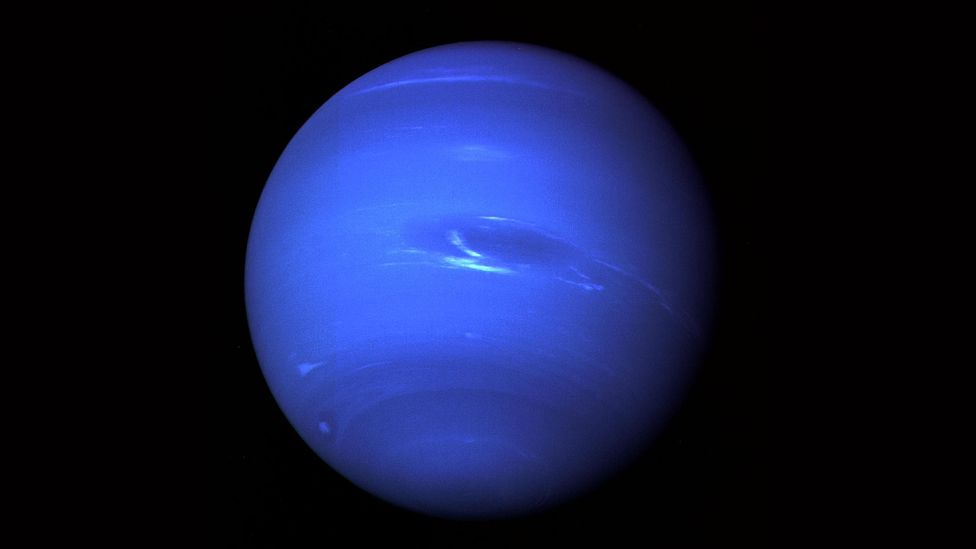
Neptune is currently the near distant known planet in our solar arrangement, but there might be another lurking across the Kuiper Chugalug (Credit: Nasa/JPL)
Then there's Batygin'due south personal favourite, which he admits is likewise "not a complete slam douse". In this scenario, the planet formed much closer to the Sun, at a time when the solar system was in its early on stages and the planets were just first to coalesce out of the surrounding gas and dust. "It kind of hung around the giant planet germination region, earlier being scattered out by Jupiter or Saturn, and subsequently had its orbit modified by passing stars," he says.
An obscure hiding identify
Of course, all this begs an obvious question – if Planet Ix is really there, why has no one seen information technology?
"I didn't take a specially potent appreciation for just how difficult would exist to detect Planet Nine until I started looking together with Mike using telescopes," says Batygin. "The reason information technology's such a tough search is because most astronomical surveys are not looking for a single affair."
For example, astronomers would normally be looking for a form of objects, such as a detail kind of planet. Even if they're rare, if you survey a wide enough expanse of space, you're likely to find something. Simply hunting downwards a specific object such as Planet Nine is a whole unlike exercise. "There'southward but one tiny portion of the sky that has information technology," says Batygin, who explains that another factor is the slightly more prosaic challenge of booking time slots to utilise the right kind of telescope.
"Really, at the moment the only game in town for finding Planet Nine is the Subaru Telescope," says Batygin. This viii.2m behemoth – located at the summit of a dormant volcano, Maunakea, in Hawaii – is capable of capturing even the weak light of afar celestial objects. This is ideal, considering the shadowy planet would be so far away, it's unlikely to be reflecting much light from the Sun.
"We have but one machine that we tin utilise, and we get maybe three nights on information technology a year," says Batygin, who was fresh from a three-night run on the telescope the previous week. "The good news is that the Vera Rubin telescope is coming online inside the next couple of years, and they are going to probably notice it." This next-generation telescope, currently under structure in Chile, will exist scanning the heaven systematically – photographing the entire available view – every few nights, to survey its contents.
An intriguing alternative
However, in that location is 1 nearly outrageously peculiar scenario in which the planet will never exist found this way – it might not exist a planet afterwards all, but a black hole.
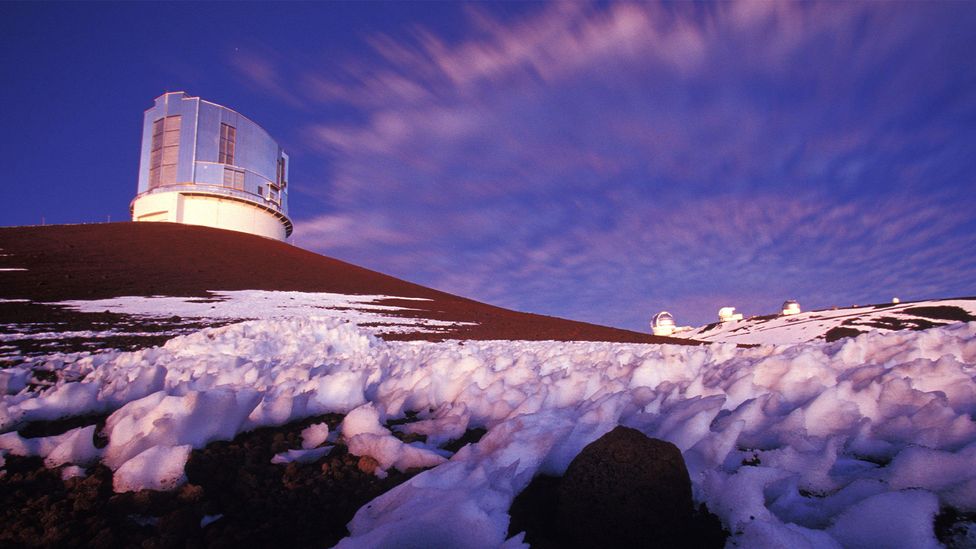
The Subaru telescope in Hawaii has already spotted the most distant known object in our solar system, nicknamed "Farfarout", during a search for Planet Nine (Credit: Alamy)
"All of the evidence for there being an object is gravitational," says James Unwin, professor of physics at the University of Illinois, Chicago, who first suggested the thought, forth with Jakub Scholtz, a postdoctoral researcher from the Academy of Turin. While we're almost familiar with the idea that planets exert a powerful gravitational pull, "there are other things that can generate it, which are more than exotic", says Unwin.
Some plausible replacements for planet ix include a small-scale ball of ultra-concentrated dark matter, or a primordial black hole. As black holes are among the most dense objects in the Universe, Unwin explains that information technology'south entirely possible the latter could be warping the orbits of distant objects in the outer solar system.
The black holes we're most familiar with tend to include "stellar" black holes, which have a mass that's at least 3 times that of our ain Sunday, and "supermassive" black holes, which are millions or billions of times our Sun'south mass, While the former are born out of dying stars collapsing in on themselves, the latter are more mysterious – possibly beginning as colossal stars which implode, then gradually accrue more and more mass by devouring everything in their surroundings, including other black holes.
Primordial black holes are unlike. They have never been observed, but are thought to originate in the hot energy-and-affair brume that formed in the first second of the Big Bang. In this uneven environs, some parts of the Universe may have become and then dense, they were compressed into tiny pockets with the mass of planets.
Unwin points out that there is zero probability of the black hole being formed from a star, since they keep their stiff gravitational pull – it's just concentrated. Even the smallest stellar blackholes have masses iii times that of our Sun, so it would exist like having at to the lowest degree three extra Suns pulling at the planets in our solar system. In short, we would definitely have noticed.
However, Unwin and Scholtz say information technology could exist a primordial black hole, since these are thought to be essentially smaller. "Considering these things are born during the early stages of the Universe, the dumbo regions they formed from could have been specially modest," says Scholtz. "As a result, the mass contained in this black hole that eventually is formed out of it can be much, much less than a star – they even tin be just a couple of pounds, similar a chunk of rock." This is more in line with the predicted mass of Planet Nine, which is thought to be equivalent to up to ten Earths.
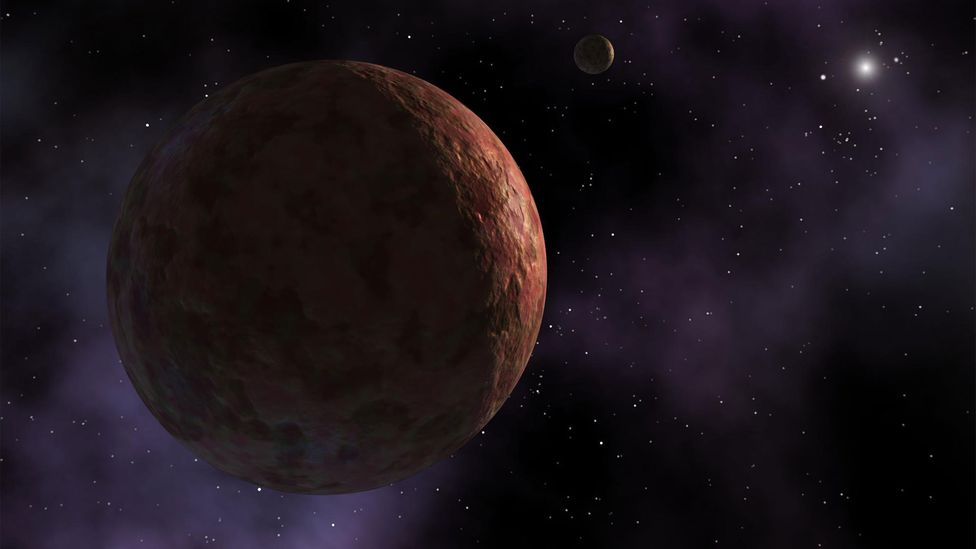
The dwarf planet Sedna has an unconventional orbit which might be explained by the gravitational pull of a massive undiscovered planet (Credit: Nasa/ JPL-Caltech)
What would it look similar? Should we be worried? And could this exist even more heady than discovering a planet?
Outset, even primordial blackness holes are dense plenty that no light can escape. They are the truest class of blackness. This ways that this one would non show up on any kind of telescope that currently exists. If you were to expect straight at it, the merely clue to its presence would be a bare void – a tiny gap in the blanket of stars in the night sky.
Which brings us to the existent snag. While the mass of this black hole would exist the same as that of the proposed Planet Nine – upwardly to 10 times Globe'southward – it would be condensed into a book roughly the size of an orangish. To find it would require some ingenuity.
So far, suggestions include looking for the gamma rays that are emitted past objects as they fall into black holes, or releasing a constellation of hundreds of tiny spacecraft, which might – if nosotros're lucky – pass close enough and then that they'd exist pulled towards it e'er-so-fractionally, and accelerate by a detectable corporeality.
Since the mysterious gravitational pull is emanating from the farthest reaches of our solar arrangement, the probes would have to exist sent via an Earthbound laser array, which could propel them to 20% of the speed of light. If they travelled any slower, they might have hundreds of years to arrive – an experiment that would, naturally, stretch well beyond a human lifetime.
As information technology happens, these futuristic spacecraft are already being developed for another aggressive mission, the Breakthrough Starshot project, which aims to send them to the Alpha Centauri star arrangement, 4.37 light-years abroad.
If nosotros were to discover a lurking black hole, rather than a frigid planet, Unwin says at that place would be no need to panic. "There's a supermassive blackness hole in the centre of our milky way," he says. "Only we don't worry near our solar system falling into it, because we're in a stable orbit around it." So, while a primitive black hole will suck up anything within its path, this would not include the World, which – similar the other inner planets – doesn't ever come close.
"Information technology'southward non similar a vacuum cleaner," says Unwin. He explains that from the perspective of anyone on Earth, having an undiscovered black hole in the solar system is not that dissimilar to having a concealed planet there.
But while stellar and primordial black holes are essentially the aforementioned, the latter have never been institute or studied – and departure in calibration is expected to atomic number 82 to some bizarre phenomena. "I would say that the things that happen with modest blackness holes are more interesting than what happens with large black holes," says Scholtz.

In 2019, the Issue Horizon Telescope (EHT) captured an epitome of the shadow of a supermassive blackness hole in the heart of the milky way Messier 87 (Credit: Alamy)
One example is the aptly-named process of "spaghettification", which is often illustrated by the fable of an astronaut who ventured too near a black hole's event horizon – the betoken beyond which no light can escape – and savage in headfirst. Though her head and feet were just metres from each other, the difference in the gravitational forces acting on them would be so great, she would be stretched similar spaghetti.
Intriguingly, the event should be even more than dramatic, the smaller the blackness hole is. Sholtz explains that it'southward all almost relative distances – if you're 2 metres tall, and you're falling through an upshot horizon that's one metre from a primordial blackness hole's centre, the discrepancy between the location of your caput and anxiety is larger, compared to the size of the black hole. This means you'll be stretched far more than than if you fell into a stellar i that'southward a million miles across.
"And and so, peculiarly enough, they're more interesting," says Scholtz. Spaghettification has already been seen via a telescope, when a star got too shut to a stellar black hole 215 million light years from Earth, and was ripped apart (no astronauts were harmed). But if at that place is a primordial blackness hole in our own solar system, information technology would provide astrophysicists with the opportunity to report this behaviour – and many others – up close.
And then what does Batygin brand of the possibility that the long-sought 9th planet could actually be a black hole instead? "It's a creative idea, and we cannot constrain what its composition is even in the least chip," he says. "I recollect mayhap information technology's merely my own bias, existence a planetary science professor, only planets are a footling chip more common…"
While Unwin and Scholtz are rooting for a primeval black hole to experiment with, Batygin is simply as neat for a giant planet – citing the fact that the almost common blazon throughout the milky way are those which have effectually the same mass as Planet Ix.
"Meanwhile about exoplanets that orbit Lord's day-like stars, are in this weird range of being bigger than the Earth and considerably smaller than Neptune and Uranus," he says. If scientists practise observe the missing planet, information technology will be the closest they tin can get to a window into those elsewhere in the galaxy.
Only time volition tell if the latest quest will be more successful than Lowell'due south. But Batygin is confident that their missions are totally different. "All of the proposals are quite singled-out in both the data they seem they seek to explicate, too as the mechanisms they utilise to explain it," he says.
Either way, the search for the legendary ninth planet has already helped to transform our understanding of the solar system. Who knows what else nosotros'll find before the chase comes to an cease.
Zaria Gorvett is a senior announcer for BBC Future and tweets @ZariaGorvett
--
This story was updated on 22/2/2021. An earlier version incorrectly stated that the Voyager ii mission led to the discovery of the Kuiper Belt.
--
Bring together ane million Future fans by liking united states on Facebook , or follow us on Twitter or Instagram .
If y'all liked this story, sign upward for the weekly bbc.com features newsletter , called "The Essential Listing". A handpicked selection of stories from BBC Future , Culture ,Worklife, and Travel , delivered to your inbox every Friday.
leathermanthandeant1974.blogspot.com
Source: https://www.bbc.com/future/article/20210216-the-massive-planet-scientists-cant-find
0 Response to "Lets Take a Chance Go Far Away Today and Never Look Back Again"
Post a Comment